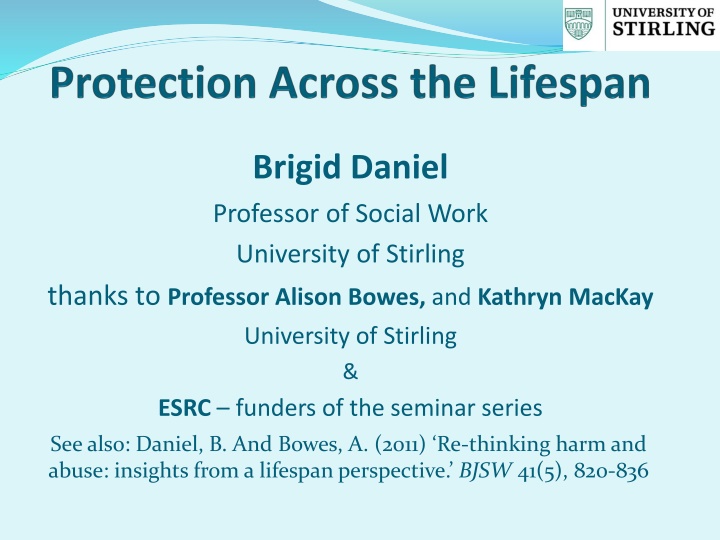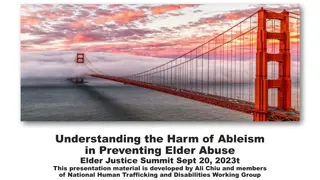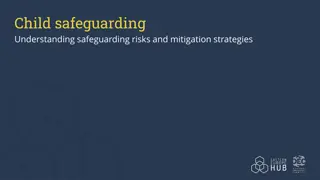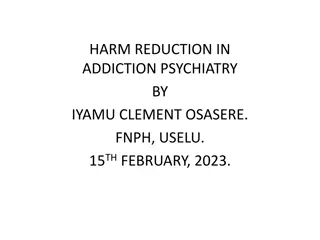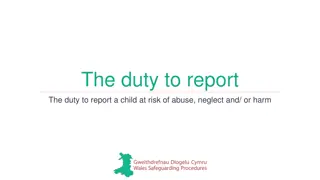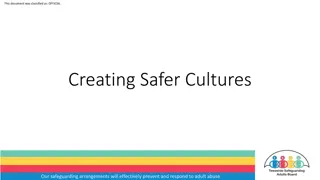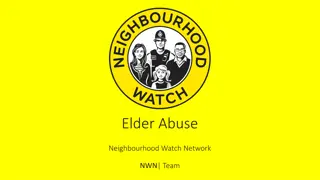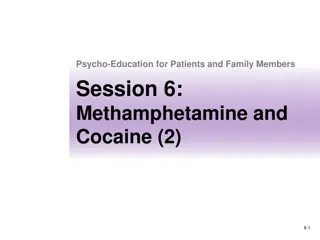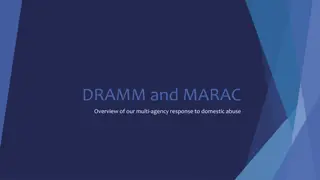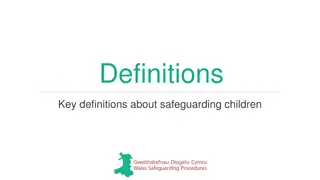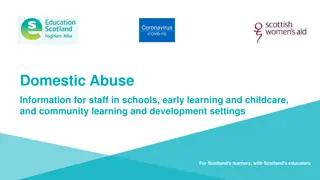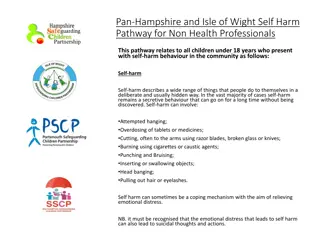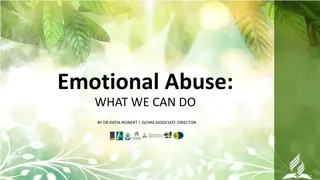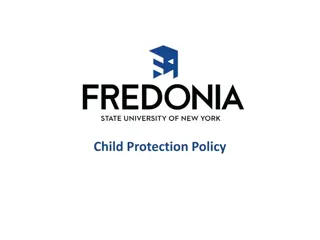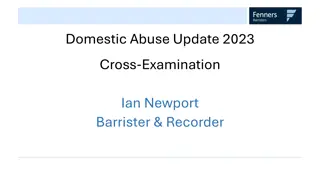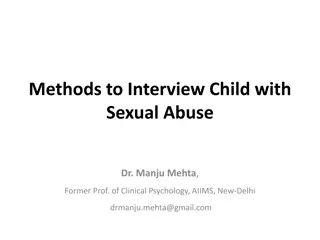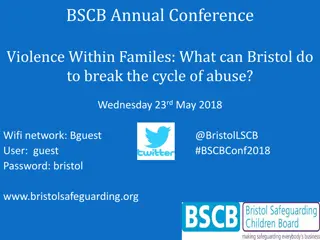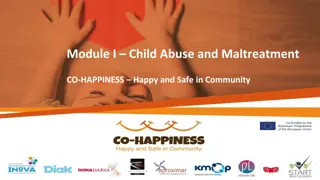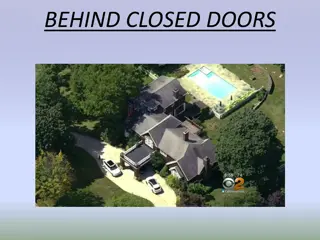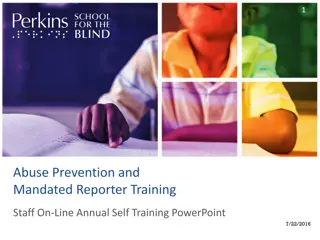Insights on Lifespan Approach to Harm and Abuse
This content discusses a lifespan approach to harm and abuse, emphasizing the continuities of experiences such as domestic abuse evolving into elder abuse. It also touches on the discontinuities of service provision and the impact of abuse at any age on developmental processes. The civil state protective response and the integration and disintegration of health and social care systems are explored, along with challenges and opportunities in research and theory.
Download Presentation

Please find below an Image/Link to download the presentation.
The content on the website is provided AS IS for your information and personal use only. It may not be sold, licensed, or shared on other websites without obtaining consent from the author.If you encounter any issues during the download, it is possible that the publisher has removed the file from their server.
You are allowed to download the files provided on this website for personal or commercial use, subject to the condition that they are used lawfully. All files are the property of their respective owners.
The content on the website is provided AS IS for your information and personal use only. It may not be sold, licensed, or shared on other websites without obtaining consent from the author.
E N D
Presentation Transcript
Brigid Daniel Professor of Social Work University of Stirling thanks to Professor Alison Bowes, and Kathryn MacKay University of Stirling & ESRC funders of the seminar series See also: Daniel, B. And Bowes, A. (2011) Re-thinking harm and abuse: insights from a lifespan perspective. BJSW 41(5), 820-836
Lifespan approach Alerts us to continuities of experience domestic abuse that morphs into elder abuse; disabled child neglected becoming a neglected adult etc; which contrasts with the discontinuities of service provision where people may be passed from one system to the next; reminds us about the capacity for life-long development - impact at any age of abuse upon developmental processes opportunity for growth at any age and stage.
Overview People are subject to many different types of harm as a result of the actions of other people - at any stage of the lifespan experiencing a range of factors that can be seen to elevate the risk of harm.
Civil state protective response has developed in distinct strands: linked with, but separate from, criminal proceedings, constructed around categories of people who are considered to be at elevated risk of harm. Children viewed as inherently vulnerable - child abuse constructed as a distinct concept -> specific child protection legislation. Disabled adults constructed as at elevated risk of harm -> specific adult support and protection legislation. Women? Domestic abuse - policies and criminal law.
Research and theory Empirical studies of state protective activities tend to match the specific categories and are in separate strands. Research on causes of harm are also often in different, parallel strands with different theoretical foundations. But research on harm and abuse also challenges the concept of parallel strands.
Integration <-> Disintegration Integration of health and social care offers opportunities for more holistic practice in some ways but Is there a danger of increasing divisions between other parts of the system eg adult / child services? Growth of models of people protection Potential for lifespan models e.g Getting it right for every citizen
Interrogating harm and abuse: protection and citizenship across the lifespan The nature of the problem: i.e. current understandings about elevated risk of harm and abuse associated with different ages and groups seen as vulnerable . 2. The most effective response: i.e. existing evidence about the most effective protective response at individual, family, community and state levels across the lifespan. 1.
The nature of the problem Children experiencing abuse. Teenagers earning a living by prostitution. People experiencing domestic abuse, including from same-sex partners. Children in households where there is domestic abuse. Deaf children experiencing abuse. Older BME women experiencing domestic abuse. Older people with dementia experiencing institutional abuse.
The nature of the response Barring people from working in social care. Mental health legislation protecting from self and others. Interactions between child protection activity and child custody decisions. Early intervention widening the net. Adult support and protection widening the net. Older people protection and paternalism. Children s participation and children s citizenship. Older people and autonomy.
The nature of the problem Rejection of the role of victim (resistance / resilience). Relationships and interactions. The nature of the response Need for a victim and a perpetrator . Service categories are unhelpful.
Explicit or implicit rejection of the role of victim I d never really thought of myself as a victim of domestic abuse . . . I don t feel like a victim, cos I think victim is a very passive, allowing it to happen, although at the time I was, in that relationship. So it might be the right term for that, but it almost suggests you can t do anything about it. (Donovan and Hester, 2011, p.285). Adolescents involved in prostitution saw themselves as survivors not victims (Williams, 2011).
Older people with dementia in a locked ward showed resistance to abusive care (Kelly, 2011). . . . the successful navigation of being deaf in a world which faces them with countless daily hassles and that may commonly deny, disable or exclude them, is a key definition of resilience. For such successful navigation to occur, a range of protective resources and repertoires of skills developed through challenging experiences of risk and responsibility have to be promoted (Young et al. 2008, p. 52).
Relationships and interactions Evidence on adult protection demonstrates the complexity of relationships and extent of inter- dependence (Hogg et al.2009). Evidence on domestic abuse in same-sex relationships highlights role of love: . . . the nice side of her outweighed the ugly side of her (Donovan and Hester, 2011). Theory is fragmented e.g attachment theory (child abuse), feminist theory (domestic abuse), caregiver strain (elder abuse), 3-selves (dementia).
Need for a victim and perpetrator . . . this victim label may do them a great disservice in the long run because the portrayal of the weak, innocent , helpless victim is directly challenged by the teen the police or a would-be service provider encounters . . ..Instead of a sad- eyed victim, they confront a strong, wilful, survivor who looks and acts quite differently from the victims portrayed in the media (Williams, 2011, p.251).
POVA list is binary - cant be partly unsuitable (Stevens and Manthorpe, 2007). Child contact with fathers after separation due to domestic violence, system can not really contain the idea of a man who is a partly good and partly bad father (Holt, 2011).
Service categories are unhelpful Deaf children need to be diagnosed to receive specialist services (Young et al. 2008). Inverted commas may be used in a case file to denote that an adult has learning difficulties and to facilitate a protective response (Hogg et al. 2009); Intervention in child abuse depends on defining sufficiently serious harm (Lockyer, forthcoming).
When people dont fit a box services struggle to respond: Domestic abuse in same-sex relationships (Donovan and Hester, 2010). Teenagers engaged in prostitution (Williams, 2011). Domestic abuse in older age. Older people of ethnic minority experiencing abuse (Manthorpe and Bowes, 2010).
When people occupy more than one box services struggle: Disabled child -> disabled adult. Young disabled people with early onset dementia. Older person domestic and / or elder abuse. Hester s three-planet model (2011) 1. child contact 2. child protection 3. criminal justice.
Generic /specialist divisions Back in 1973 Vickery argued that there will always be a need to divide tasks into manageable packages but that this division should not be based upon administrative convenience but should consider spheres of knowledge and skill that are required.
So what? Validates the experience of practitioners who are constantly tussling with grey areas. Theory and research need to cross-fertilise - strategic structures are merging e.g people protection committees. Helps with developing nuanced approaches to personalisation - removing boxes c.f. manageable packages and administrative convenience (Vickery, 1973). Reminds us not to overlook people s self-protection activities (resistance and resilience). Equalities legislation is harmonising does protective legislation need also to harmonise?
